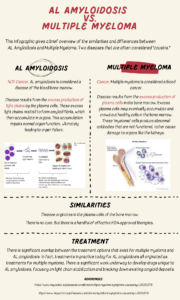While both AL Amyloidosis and Multiple Myeloma are plasma cell disorders and share similar patient care treatments, they diverge in pathogenic mechanisms. In this presentation, Dr. Giada Bianchi from Brigham & Women’s Amyloidosis Program shares that 10-15% of Multiple Myeloma patients will experience overlapping AL Amyloidosis, elevating the importance of understanding the similarities and differences in diagnostic criteria and patient care.
Slider
AL Amyloidosis vs Multiple Myeloma
In the AL amyloidosis community, multiple myeloma is often mentioned. Between 10% and 15% of people who have multiple myeloma develop AL amyloidosis. In reality, while there are ample similarities where some view these diseases as “cousins,” there are important differences. Here we summarize these two rare blood diseases.
